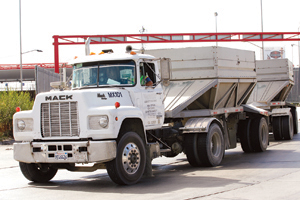Mexican Trucks OK for US Roads Based on Safety Data, Foxx Says

This story appears in the Jan. 19 print edition of Transport Topics.
The United States will grant operating authority to longhaul Mexican carriers that meet the financial and operating standards for U.S. truckers, the Department of Transportation announced, three months after a pilot program for such carriers ended.
The Jan. 9 announcement came more than 20 years after the North American Free Trade Agreement required the border be opened to Mexican carriers.
Transportation Secretary Anthony Foxx said DOT had sufficient safety data to justify opening the border to more Mexican truckers despite a recent report from the department’s Inspector General that said the pilot had too few participants to conclude whether all Mexican trucks would operate safely here.
BEFORE BORDER OPENED: 1,000+ Mexican carriers already operated in U.S.
“There were also legacy carriers that provided us with data that was also used to supplement the data that we got from the pilot, and the combination of those two data sets gave us sufficient information to move forward,” Foxx told Transport Topics.
Foxx’s reference was to 1,000 Mexican carriers — in addition to the 15 in the pilot program — that already have operating authority to run longhaul on U.S. highways. Those carriers have demonstrated “a level of safety at least as high as their American and Canadian counterparts,” Foxx said in an earlier statement that accompanied the DOT announcement.
The DOT announcement, however, drew fire from labor and some in the trucking industry and Congress who have fought Mexican trucks operating in the United States.
Teamsters President Jim Hoffa said he was “outraged” that DOT chose to “ignore” the IG report on the pilot, which he called a failure because it had only 15 participants.
“Allowing untested Mexican trucks to travel our highways is a mistake of the highest order, and it’s the driving public that will be put at risk by the DOT’s rash decision,” Hoffa said in a statement.
Todd Spencer, executive vice president of the Owner-Operator Independent Drivers Association, said: “The FMCSA is clearly doing an end-around and playing with numbers to try and justify opening the border to longhaul trucks from Mexico.”
American Trucking Associations, however, said it supports a border policy that allows foreign motor carriers in the United States as long as they comply with the regulatory and financial requirements that apply to U.S. carriers.
“Nothing less is acceptable to ATA,” the federation said in a statement.
Congressional critics also directed their ire at DOT for discounting the IG’s report on the pilot.
Rep. Daniel Lipinski (D-Ill.) said he will talk with his colleagues about “what we can do to put a stop to this, at least until we have a pilot program that does give us statistically sufficient data to show that there are no safety concerns.”
Lipinski also said he doesn’t believe the safety data from the approximately 1,000 carriers — known as certificate and enterprise carriers — running in the United States “is necessarily a valid comparison” to the carriers in the pilot.
Rep. Peter DeFazio (D-Ore.), ranking member on the House Transportation and Infrastructure Committee, said the IG report showed that we do not “truly know” whether Mexican carriers pose a safety risk on U.S. roads.
“This administration appears insistent on creating opportunities for Mexican carriers — which will have major impacts on safety, security and American jobs,” DeFazio said.
He said Mexican drivers “can be on the road for days in Mexico prior to being subject to American hours-of-service requirements when they cross the border.”
According to FMCSA, carriers in the pilot were required to have electronic logging devices that monitored hours of service, but certificate and enterprise carriers operating here are not currently required to do so.
But all Mexican trucks operating here will have to have the devices once the U.S. rule on mandatory ELDs is operative, said FMCSA, which has published a proposed but not a final rule.
It is not known how many new Mexican carriers will seek operating authority in the United States.
“We’ll see,” Foxx told TT.
Opening the border “is expected to result in the permanent termination of more than $2 billion in annual retaliatory tariffs on U.S. goods,” the DOT announcement said.
In 2001, a Nafta dispute settlement panel said the United States was not in compliance with the cross-border trucking provisions of the trade treaty. The United States agreed to do a demonstration program for Mexican trucks, but in 2009 Congress used its appropriations power to halt the demonstration. Mexico then “exercised its option to take retaliatory measures” and imposed tariffs on exports of U.S. agricultural and other products, the DOT announcement said.
Mexico “suspended” the tariffs after the new pilot program began in 2011.

